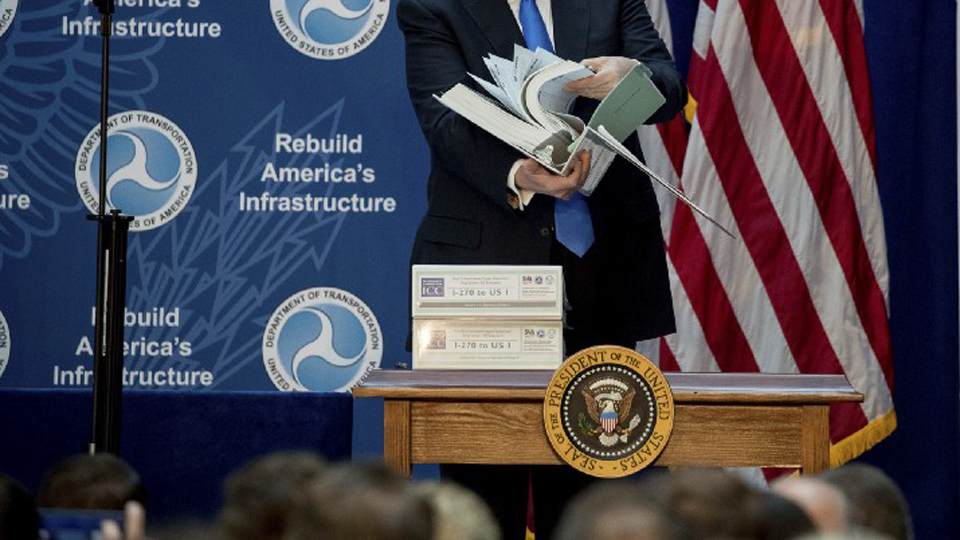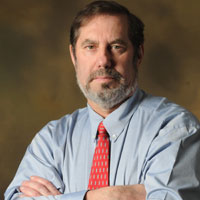
Donald Trump surrounds himself in gold. The signs on Trump buildings shimmer in it. His penthouse in New York is gilded in it.
He claims now to have found the alchemy to conjure $1 trillion in infrastructure gold. He plans to put up a mere $200 billion in federal funds and stir it together with $800 billion in private investment and state dollars.
That is fool’s gold. A falsely-funded infrastructure program is a massive broken promise. America needs real improvements to roads, bridges, schools, hospitals, airports, water systems and railways.
That requires a commitment of real tax dollars, not the relinquishment of America’s public assets to profit-seeking private Wall Street entities. Americans should not be charged twice for maintenance of the public good, once through tax breaks to investors and again in outrageous tolls and fees the investors charge.
Standing on the banks of the Ohio River in Cincinnati, Trump reiterated the pledge he made repeatedly on the campaign trail to put $1 trillion into infrastructure. He said “restoring America” is a promise that Washington, D.C., has broken. “It has not been kept, but we are going to keep it,” he said.
“Taxpayers deserve the best results for their investment,” he said, “and I will be sure that is what they get.” But the plan to turn over public assets to private corporations for tax-supported investment is gold only for the 1 percent who can afford to invest.
The Wall Street Journal reported last fall that to raise the private funds, Trump planned to give massive tax breaks of 82 percent of equity to investors that help pay for infrastructure repair. For citizens, that’s a crappy deal – giving Wall Street control over public assets in addition to being forced to fork over the taxes that rich investors will not pay.
That financial alchemy creates poison, not gold.
In addition, there is no profit in many types of infrastructure that need repair, like schools and hospitals. A corporation can’t collect tolls from children entering their elementary school each morning.
Despite Trump’s promise in Cincinnati that he would take care of rural areas, there’s no profit in many crucial infrastructure projects in such regions. Investors won’t pay for a highway needed to connect two isolated towns in West Virginia.
And the profit in some projects is highly questionable. Several corporations that have bought or built toll roads have filed for bankruptcy. This includes highways in Texas, California, Indiana and Alabama.
In other cases, the profits reaped are outrageous. After Chicago sold its 36,000 parking meters to Morgan Stanley, the Wall Street bank doubled the parking rates and charged the city tens of millions annually for meters Chicago took out of service for street repairs, mass transit stops and safety.
A city inspector general report on the deal says Chicago underpriced the meters by nearly $1 billion when former Mayor Richard M. Daley signed the 75-year contract in 2008. The bank is expected to make back its $1.15 billion investment by 2020, giving it 60 more years to rake in pure profit on the backs of Chicago taxpayers who paid to install the meters and who feed them daily.
That’s gold for Morgan Stanley, grief for taxpayers.
Another part of Trump’s financing plan is to shift infrastructure costs to states and towns. This also cheats too many citizens. Sure, some places high on the hog like Silicon Valley might be able to afford that. But too many will be left out.
That’s because large numbers of cities and states are facing fiscal crises. Chicago sold its parking meters to fill a budget shortfall. In Oklahoma, where there’s a $900 million budget gap, schools are so underfunded that 96 of the state’s 513 districts have reduced the school week to four days and another 44 may be forced to do that in the fall. The state has shuttered rural hospitals, overcrowded its prisons and limited state troopers to 100 miles of driving a day.
In Kansas, with a $1.1 billion budget deficit, the state Supreme Court just ordered the legislature to properly pay for its schools. The court said Kansas’ underfunding meant inadequate education in basic reading and math for students in one fourth of its public schools. The state shortchanged half of the state’s black students and a third of its Hispanic pupils.
Illinois hasn’t had a budget for two years. The state’s credit rating has been downgraded eight times. It has accrued $14.5 billion in unpaid bills. As a result, more than 1,500 public university and community college workers have been laid off and untold numbers of social service agencies have closed or severely curtailed services.
shortfalls after years of failing to properly pay into the funds.
These places aren’t going to be able to jump up and take on the federal government’s responsibility to invest in infrastructure.
Even the $200 billion that the Trump administration is saying the federal government will provide is in question. It’s in the budget Trump submitted to Congress, but also in that budget is $206 billion in cuts to existing infrastructure programs, including those conducted by the U.S. Department of Transportation and the Army Corps of Engineers. That’s the very Corps of Engineers that would pay for the river lock and dam projects that Trump complained in Cincinnati were grossly underfunded, causing costly breakdowns.
That kind of budgeting is bad alchemy. That’s not $1 trillion in infrastructure gold.
Trump said, “We will build because our people want to build and because we need them to build. We will build because our prosperity demands it. We will build because that is how we make America great again.”
That sounds wonderful. But to build, projects must be properly paid for. And so far, the Trump administration has offered only pyrite.










